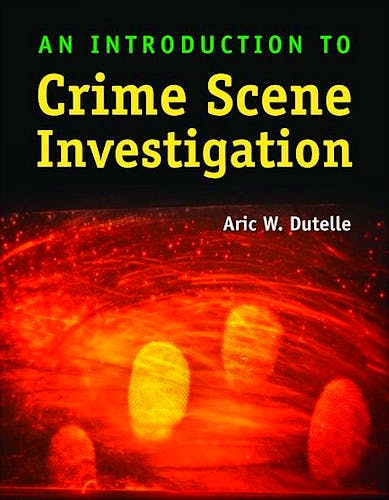

No hay productos en el carrito



An Introduction to Crime Scene Investigation
Dutelle, A.
1ª Edición Marzo 2010
Inglés
Tapa blanda
415 pags
1200 gr
null x null x null cm
ISBN 9780763762414
Editorial JONES AND BARTLETT
LIBRO IMPRESO
-5%
76,14 €72,33 €IVA incluido
73,21 €69,55 €IVA no incluido
Recíbelo en un plazo de
2 - 3 semanas
In a world profoundly influenced by popular media programs, the real-life duties and complexities involved in crime scene investigation are often misrepresented and misunderstood. An Introduction to Crime Scene Investigation serves to eliminate warped impressions and to clearly identify and accurately explain the crime scene investigative process, components, methods, and procedures. This comprehensive introductory text exposes readers to the day-to-day aspects of crime scene processing, and describes in detail the crime scene investigator responsibilities. The history related to crime scene investigation, theory, ethics, social impact, training, and educational issues are thoroughly explored as well.
Features:
- Presents straightforward and scientifically supported procedures that explain how to accurately and efficiently document what has been left behind at the scene of a crime.
- Provides an in-depth look at the CSI world through over 100 photographs, illustrations, and short narrative segments that will guide the reader through investigations.
- Effectively covers a variety of investigations such as burglary, homicide, sex crimes, drug cases, underwater crime scenes, hazardous materials situations, and arson.
Key Features
- A pragmatic, critical, and multidisciplinary approach.
- Written at the level of a reader who has very little, or only an introductory background in crime scene investigations.
- Learning Objectives: Listed at the beginning of each chapter. Emphasis is placed on active learning rather than passive learning. The reader will gain knowledge of how to apply the concepts and material. The learning objectives concentrate on the acquisition of knowledge and foundations needed to understand, compare, contrast, define, explain, predict, estimate, evaluate, plan, and apply.
- Key Terms: Listed at the beginning of each chapter to familiarize readers with the important terminology and vocabulary associated with the field of crime scene investigation.
- Review Questions: Provided to reinforce knowledge and skills. Meant for student self-study options, and also for use by instructors who are developing written assignments, and examinations.
- "Ripped From the Headlines” Current Event Examples: “Real world” incidents involving the content are discussed in every chapter. This application to “real world” situations will enable the reader to better grasp the concepts and theories presented.
- "Case in Point” Examples: In addition to current events, there are also case scenarios and summations which assist the reader in further comprehending the presented material.
- "View from an Expert” Insights: Many chapters include these insights from a forensic expert within the chapter content field.
- Case Studies: At the conclusion of many of the chapters the reader will find case studies which challenge the reader to seek out additional information from outside sources to assist them with a more in-depth comprehension of the presented material.
- References: In addition to that which is cited within the footnotes, each chapter is supplemented with suggested readings pertaining to the key areas addressed within the chapter.
Table of Contents
Part 1 CSI
Chapter 1 An Introduction to Crime Scene Investigation
Chapter 2 The “CSI Effect”
Chapter 3 Ethics in Crime Scene Investigation
Chapter 4 The Duties of First Responders to the Crime Scene
Chapter 5 Specialized Personnel and Safety Considerations
Chapter 6 Methodological Approach to Processing the Crime Scene
Chapter 7 The Forensic Laboratory
Part 2 Physical Evidence
Chapter 8 Fingerprints
Chapter 9 Trace Evidence and Miscellaneous Material
Chapter 10 Blood and Biological Evidence
Chapter 11 Blood Pattern Analysis
Chapter 12 Impression Evidence
Chapter 13 Firearms and Ballistic Evidence
Chapter 14 Arson and Explosive Evidence
Chapter 15 Drug Evidence
Chapter 16 Digital Evidence
Part 3 Specialized Investigations
Chapter 17 Death Investigation
Chapter 18 Special Scene Considerations
About the Author(s)
Aric W. Dutelle - M.F.S., Criminal Justice Department, University of Wisconsin-Platteville
Aric Dutelle has been involved in law enforcement for over a decade. During this time he has held positions as a police officer, deputy sheriff, crime scene technician, and reserve medico-legal investigator. He has a Master of Forensic Sciences (M.F.S.) degree, is a POST certified law enforcement officer, and a Wisconsin Law Enforcement Standards Board certified instructor in: Hazardous Materials, Interview and Interrogation, Physical Evidence Collection, Report Writing, Scene Management, Testifying in Court, and Traffic Crash Investigation. Since 2004, he has taught crime scene related courses at the University of Wisconsin-Platteville. He is currently responsible for the Forensic Investigation program within the Department of Criminal Justice.
In addition to his University obligations, since 2006, the author has been a forensic instructor for the U.S. Department of Justice’s International Criminal Investigation Training Assistance Program (ICITAP), specializing in and providing training in crime scene processing methodologies and techniques around the globe. He continues to be actively involved in training, consulting, and assisting law enforcement agencies with criminal investigations and crime scene processing around the United States, and internationally.
Throughout these experiences, the author worked on thousands of crime scenes, both in the United States and internationally, including: kidnappings, homicides, suicides, robberies, burglaries, sexual assaults, and drug trafficking-related cases.
© 2025 Axón Librería S.L.
2.149.0